

Designing for a Quality Online Course. In this online resource, the model used for course development is a project team-based structure.
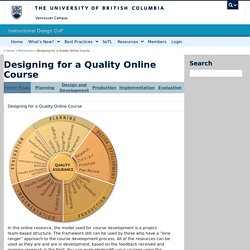
The framework still can be used by those who have a "lone ranger" approach to the course development process. All of the resources can be used as they are and are in development, based on the feedback received and ongoing research in the field. You can evaluate/modify your courses using the checklists provided in this module. PDPIE Framework: Online Course Development Quality Cycle. i2516e. Methodology Wars: ADDIE vs. SAM vs. AGILE. Learning methodologies are cheat sheets.
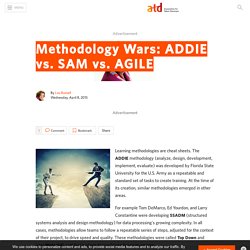
The ADDIE methodology (analyze, design, development, implement, evaluate) was developed by Florida State University for the U.S. Army as a repeatable and standard set of tasks to create training. At the time of its creation, similar methodologies emerged in other areas. For example Tom DeMarco, Ed Yourdon, and Larry Constantine were developing SSADM (structured systems analysis and design methodology) for data processing's growing complexity. In all cases, methodologies allow teams to follow a repeatable series of steps, adjusted for the context of their project, to drive speed and quality. ADDIE vs AGILE: How to set up fast and effective eLearning production. The best production process isn’t the one that gets course content before an audience as quickly as possible.
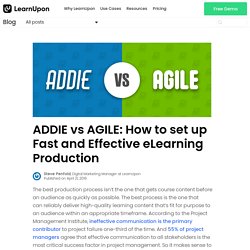
The best process is the one that can reliably deliver high-quality learning content that’s fit for purpose to an audience within an appropriate timeframe. According to the Project Management Institute, ineffective communication is the primary contributor to project failure one-third of the time. And 55% of project managers agree that effective communication to all stakeholders is the most critical success factor in project management. So it makes sense to develop a production process that involves all stakeholders and provides a transparent system everyone can follow. Here are two proven production models that you should consider when developing eLearning. 1.
ADDIE has been around since the 1950s. Analysis This initial fact-finding phase allows you to define your project and get buy-in and collaboration from all stakeholders. Who is the target audience? Instructional Design Models and Theories. Share on StumbleUpon0 shares on StumbleUpon Courses & Certification Instructional Design Certificate (Fully Online).
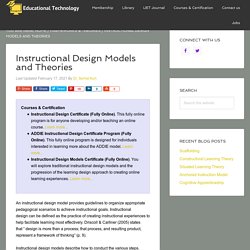
This fully online program is for anyone developing and/or teaching an online course. Learn more... ADDIE Instructional Design Certificate Program (Fully Online). This fully online program is designed for individuals interested in learning more about the ADDIE model. An instructional design model provides guidelines to organize appropriate pedagogical scenarios to achieve instructional goals. Instructional design models describe how to conduct the various steps. Branch & Kopcha say that “instructional design is intended to be an iterative process of planning outcomes, selecting effective strategies for teaching and learning, choosing relevant technologies, identifying educational media and measuring performance” (p. 77).
2176 10295 1 PB. Sabias que. SAMRandTPCK HandsOnApproachClassroomPractice. Traduccionmodelosamr. Diseño instruccional. EVA4. Diseñadores instruccionales del siglo XXI: cruzando las brechas perceptuales entre la identidad, práctica, impacto y desarrollo profesional. Fecha de presentación: mayo de 2014 Fecha de aceptación: octubre de 2014 Fecha de publicación: julio de 2015 Cita recomendada Sharif, A. y Cho, S. (2015).
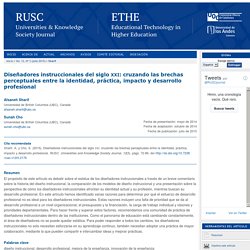
Diseñadores instruccionales del siglo XXI: cruzando las brechas perceptuales entre la identidad, práctica, impacto y desarrollo profesional. Resumen El propósito de este artículo es debatir sobre el estatus de los diseñadores instruccionales a través de un breve comentario sobre la historia del diseño instruccional, la comparación de los modelos de diseño instruccional y una presentación sobre la perspectiva de cómo los diseñadores instruccionales afrontan su identidad actual y su profesión, mientras buscan su desarrollo profesional. Palabras clave diseño instruccional, desarrollo profesional, mejora de la enseñanza, innovación de la enseñanza 21st-Century Instructional Designers: Bridging the Perceptual Gaps between Identity, Practice, Impact and Professional Development Abstract Keywords Introducción ¿Qué es un diseñador instruccional?
Método. Untitled. History of the ADDIE Model. ADDIE (Analysis, Design, Development, Implement, and Evaluate) is a model of the ISD family (Instructional System Design).
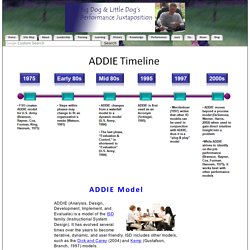
It has evolved several times over the years to become iterative, dynamic, and user friendly. ISD includes other models, such as the Dick and Carey (2004) and Kemp (Gustafson, Branch, 1997) models. While the concept of ISD has been around since the early 1950s, ADDIE first appeared in 1975. It was created by the Center for Educational Technology at Florida State University for the U.S. Army and then quickly adapted by all the U.S. As defense machinery was becoming more and more sophisticated, the educational background of entry level soldiers was becoming lower and lower. The ADDIE or ISD model consisted of 19 steps that were considered essential to the development of educational and training programs (Hannum, 2005).